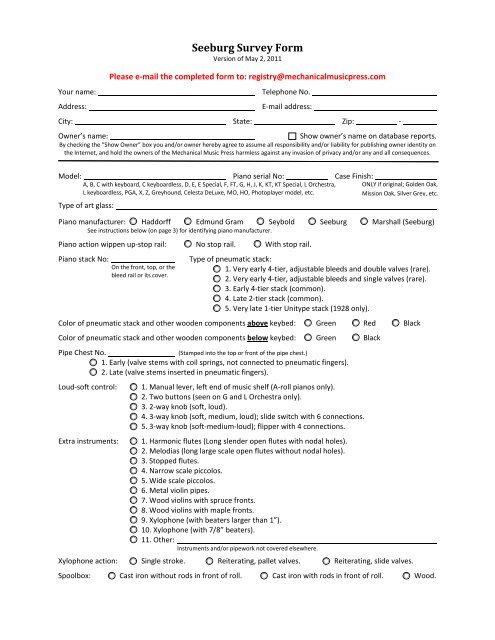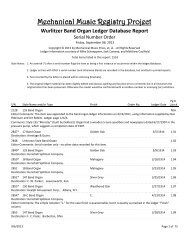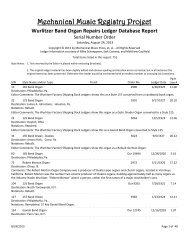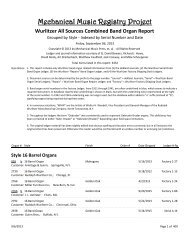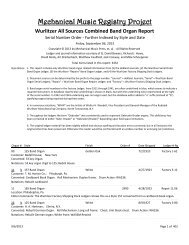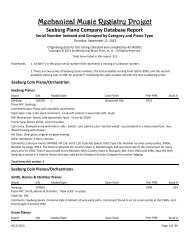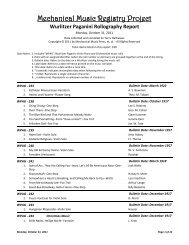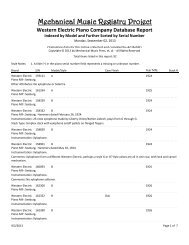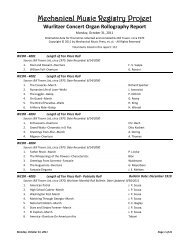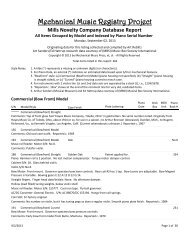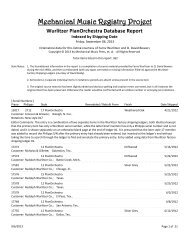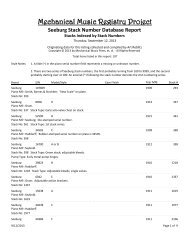Seeburg Survey Form - Mechanical Music Press
Seeburg Survey Form - Mechanical Music Press
Seeburg Survey Form - Mechanical Music Press
Create successful ePaper yourself
Turn your PDF publications into a flip-book with our unique Google optimized e-Paper software.
Your name:Address:<strong>Seeburg</strong> <strong>Survey</strong> <strong>Form</strong>Version of May 2, 2011Please e-mail the completed form to: registry@mechanicalmusicpress.comTelephone No.E-mail address:City: State: Zip: -Owner’s name:___ Show owner’s name on database reports.By checking the “Show Owner” box you and/or owner hereby agree to assume all responsibility and/or liability for publishing owner identity onthe Internet, and hold the owners of the <strong>Mechanical</strong> <strong>Music</strong> <strong>Press</strong> harmless against any invasion of privacy and/or any and all consequences.Model: Piano serial No: Case Finish:A, B, C with keyboard, C keyboardless, D, E, E Special, F, FT, G, H, J, K, KT, KT Special, L Orchestra, ONLY if original; Golden Oak,L keyboardless, PGA, X, Z, Greyhound, Celesta DeLuxe, MO, HO, Photoplayer model, etc.Mission Oak, Silver Grey, etc.Type of art glass:Piano manufacturer: ___ Haddorff ___ Edmund Gram ___ Seybold ___ <strong>Seeburg</strong> ___ Marshall (<strong>Seeburg</strong>)See instructions below (on page 3) for identifying piano manufacturer.Piano action wippen up-stop rail: ___ No stop rail. ___ With stop rail.Piano stack No:Type of pneumatic stack:___ 1. Very early 4-tier, adjustable bleeds and double valves (rare).___ 2. Very early 4-tier, adjustable bleeds and single valves (rare).___ 3. Early 4-tier stack (common).___ 4. Late 2-tier stack (common).___ 5. Very late 1-tier Unitype stack (1928 only).Color of pneumatic stack and other wooden components above keybed: ___ Green ___ Red ___ BlackColor of pneumatic stack and other wooden components below keybed: ___ GreenPipe Chest No.(Stamped into the top or front of the pipe chest.)___ 1. Early (valve stems with coil springs, not connected to pneumatic fingers).___ 2. Late (valve stems inserted in pneumatic fingers).Loud-soft control:Extra instruments:On the front, top, or thebleed rail or its cover.___ Black___ 1. Manual lever, left end of music shelf (A-roll pianos only).___ 2. Two buttons (seen on G and L Orchestra only).___ 3. 2-way knob (soft, loud).___ 4. 3-way knob (soft, medium, loud); slide switch with 6 connections.___ 5. 3-way knob (soft-medium-loud); flipper with 4 connections.___ 1. Harmonic flutes (Long slender open flutes with nodal holes).___ 2. Melodias (long large scale open flutes without nodal holes).___ 3. Stopped flutes.___ 4. Narrow scale piccolos.___ 5. Wide scale piccolos.___ 6. Metal violin pipes.___ 7. Wood violins with spruce fronts.___ 8. Wood violins with maple fronts.___ 9. Xylophone (with beaters larger than 1”).___ 10. Xylophone (with 7/8” beaters).___ 11. Other:Instruments and/or pipework not covered elsewhere.Xylophone action: ___ Single stroke. ___ Reiterating, pallet valves. ___ Reiterating, slide valves.Spoolbox: ___ Cast iron without rods in front of roll. ___ Cast iron with rods in front of roll. ___ Wood.
Instructions for Identifying Piano TypesHaddorff Piano, Rockford, Illinois: If a <strong>Seeburg</strong> has a rubber-stamped serial number, the piano was made by Haddorff. Thepinblock is open face, and the lower part of a keyboard-style piano plate was originally painted black. Haddorff numbers used in<strong>Seeburg</strong> instruments run from about 19,000 (1907) to 96,000 (1922).Edmund Gram Piano, Milwaukee, Wisconsin: If a <strong>Seeburg</strong> piano has large cloverleaf-shaped holes in the lower portion of theplate, and a die-stamped serial number between about 5,600 (1910) and 12,400 (1917), the piano was made by Edmund Gram.Seybold (E.P. Johnson) Piano, Elgin, Illinois: If a <strong>Seeburg</strong> piano has each consecutive group of three tuning pins staggered upand down more than usual, the piano was made by Seybold. The plate completely covers the pinblock, and the serial number isdie-stamped. A separate <strong>Seeburg</strong> overlay pate covers the Seybold name at the upper right corner of the plate. Seybold numbersused in <strong>Seeburg</strong> instruments run from about 16,000 (1912) to 20,000 (1913).<strong>Seeburg</strong> Piano: If a <strong>Seeburg</strong> has a die-stamped number between 50,000-55,xxx, or over 155,000, it was made in the <strong>Seeburg</strong>factory. <strong>Seeburg</strong>-made piano numbers run to 168,xxx (early 1929). For the first few years of production, <strong>Seeburg</strong> usedkeyboard-style piano plates with cloverleaf holes, resembling Edmund Gram piano plates but slightly smaller. Later <strong>Seeburg</strong>shave a simplified plate design.Marshall Piano: When <strong>Seeburg</strong> began making pianos around 1920, a few had the “Marshall” name cast into the plate, a tradename intended for home pianos and player pianos in the event that prohibition cut into coin piano sales. When few homeinstruments were sold, and speakeasies proved to be good customers for coin pianos, the Marshall name was dropped, andmost 1920s vintage <strong>Seeburg</strong> machines have the <strong>Seeburg</strong> name cast into the plate without an overlay.How to Use and Return this <strong>Form</strong>This form is designed to be downloaded and then filled-in by opening it in Adobe Acrobat or Reader, version 9(or later), so that it can easily be filled-in, completed and then e-mailed back to the <strong>Mechanical</strong> <strong>Music</strong> <strong>Press</strong> at:registry@mechanicalmusicpress.com.Adobe Acrobat Reader, Version 9, (or later, if not already installed on your computer) can be downloadedfree from: http://www.adobe.com/prodindex/acrobat/readstep.html.Step by Step Fill-in Instructions1. EMAIL CLIENT: An email client (such as Eudora, Microsoft Office Outlook, Mozilla Thunderbird,Opera Mail, etc.) must be installed on the same computer as Adobe Acrobat or Reader, otherwiseit will not be possible to email the PDF <strong>Form</strong> file once it is filled-in and completed.2. FIELD COLOR: All fill-in fields will be highlighted in light blue (unless “Highlight Fields” is disabled).Any field surrounded with a red box is REQUIRED and MUST be filled-in before the form can besubmitted.3. Clicking on a field places the active cursor inside the field so that you can begin typing. Whenfinished with any particular field press either the TAB key (to automatically move to the next tabbingorder field) or click on any other field of choice and begin typing.4. SUBMIT FORM: When finished filling in the form click on the “Submit <strong>Form</strong>” button (at top right ofworkspace pane) to email the form, OR go to the Acrobat “File” menu, click on “Save As…” andrename and save the file as desired and then manually email the saved PDF file toregistry@mechanicalmusicpress.com.5. PRINTING: To print this form (for your own records) click on the Acrobat “File” menu’s “Print”option. Adobe Acrobat Reader may not allow the filled-in data to be saved, only printed.All submissions to the <strong>Mechanical</strong> <strong>Music</strong> <strong>Press</strong> and/or the <strong>Mechanical</strong> <strong>Music</strong> Registry are given with the provision that the <strong>Mechanical</strong><strong>Music</strong> <strong>Press</strong> and/or its authors have non-exclusive use of the information, images, and other matter for use with this project or in anyother media or sharing with others, without limitation. All contributors of significant, previously unused information will be listed ascontributors under general credits. Submission does not guarantee the acceptance of or the use of the whole or any part or segment.Page 3


